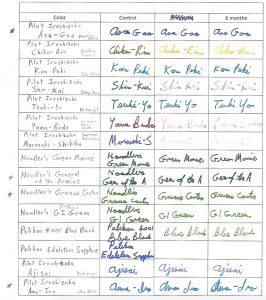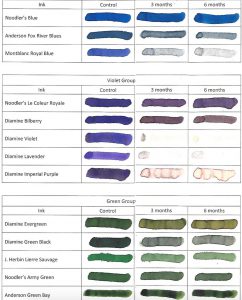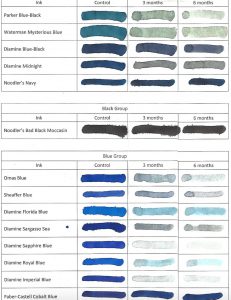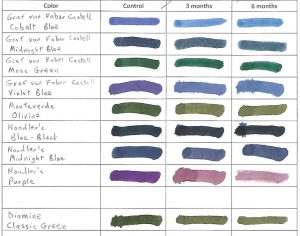With four moves in 2 years and a ton of other life changes, we were slow to test the new Lamy Crystal fountain pen inks to see how they would handle ultraviolet light and aging on paper. Luckily, we were able to start our three-month test this July. We actually let the test run about 3 and a half months.
To run our test, we used two sheets of Rhodia paper. Each of the 10 inks was first written on to the margin with a wet-writing glass dip nib. Then a swatch was drawn with a Q-tip with the intention of having a thick patch of ink and a thinned out portion so we could see the effects of UV light. One of the sheets was saved in a cool, dark, dry place. The other sheet was posted in the sunniest window of our office. The inks tested were called: Obsidian, Azurite, Ruby, Topaz, Amazonite, Beryl, Benitoite, Agate, Peridot and Rhodonite.
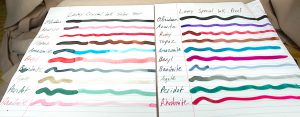
For nearly 3 and a half months, we tested the left sheet of paper with 10 Lamy Crystal inks in the direct sunlight to see how much they would or wouldn’t fade.
Here are the results. If you click the photo, you will see a larger version of the photo. It is surprising how much some of the inks change and others do not change.
To the relief of many, the Lamy Crystal Obsidian black ink holds fast. It only fades a little, unlike a suprising number of black inks. Yet, the purplish blue “Azurite” fades heavily to a reddish color that looks like if you dipped your finger in merlot and wiped it on a piece of paper.
Ruby and Topaz both held their red and sepia-brown colors very well during their time in the sun.
Peridot landed right in the middle. If the green was laid down thickly, it held. If it was thin, it faded.
Benitoite might also have a middle grade for its time in the sun. It was the only color that got darker! Benitoite is a blue-black. It lost most of its blue in the transition, but its black got stronger.
Amazonite is an odd color change. To me, it is one of the two most beautiful colors when laid down fresh. It is a very vibrant green-blue. And when set thickly on the page, it remains dark after time in the sun. Yet, the odd part is that the green gets lost in the sun and a faded blue remains. Normally, blue is the color we’ve seen disappear.
Beryl is my other favorite color when fresh. It is a lovely purply pink. Yet, after 3 months of sunlight, it completely changed to a very faded red. Even the thick/dark parts of the ink faded to a red, which itself is a faded color though remained darker.
The two colors that faded the most were Agate and Rhodonite. Rhodonite starts a beautiful reddish-pink and faded to a barely visible pink. The Agate was a light grey that actually turned light brown also fading to nearly invisible.
Hopefully, this information helps you with your ink obsession. Happy writing!


 Shopping Cart
Shopping Cart




